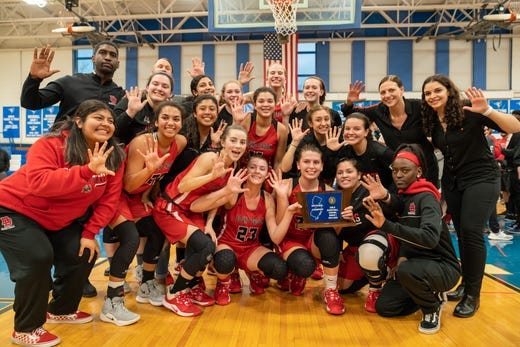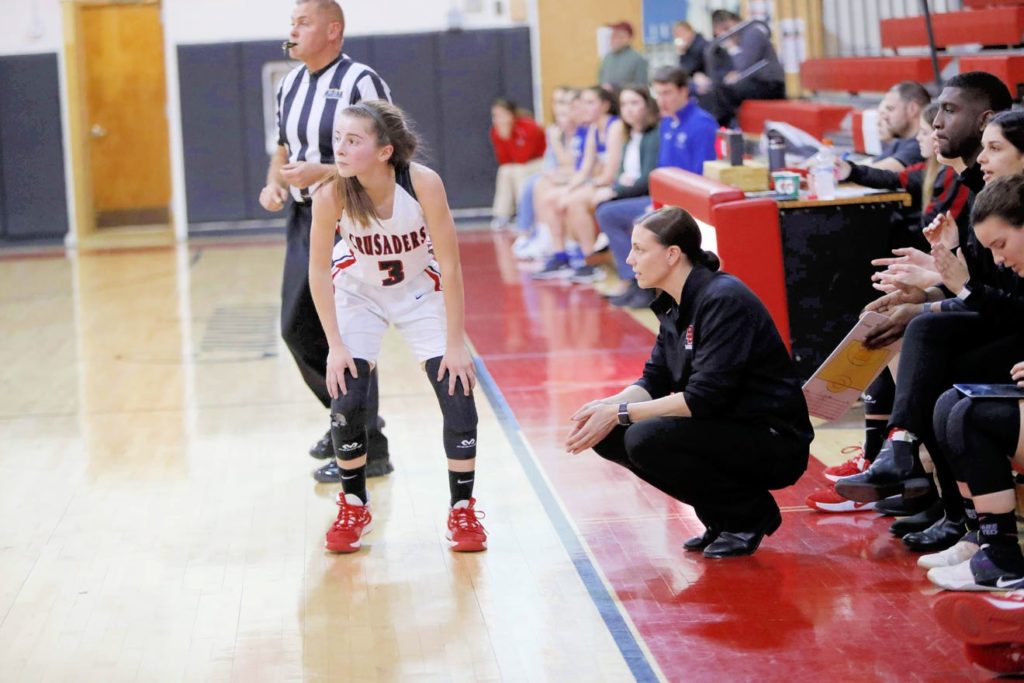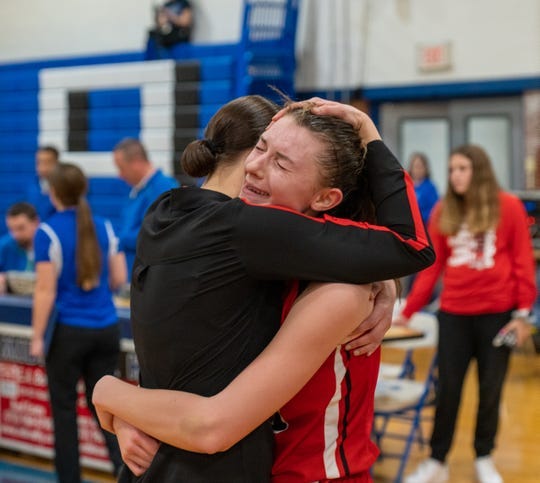
Men and women are different.
Aren’t we?
Equal in many ways, but…
¡Que viva la diferencia!
To wit, check out Bound Brook’s killa Coach Jen.
And know this:
Youth sports needs MORE WOMEN coaching girls. Which is not, in any way, shape or form, to suggest or insinuate that co-ed and boys teams (at the recreational and travel levels) do not sorely need more female coaches too: THEY DO.
In January, Tom Farrey—who heads up the Aspen Institute’s Sports & Society program—and his editorial director Jon Solomon, sent me deep into New Jersey Youthsportszanilandia, to profile a girls’ High School basketball program.
There I met a head coach, her two assistant coaches (one male, one female), their athletic director (a veteran top-level youth coach himself) and 18 superb young women-in-the-making, who will most certainly morph into great corporate or entrepreneurial teammates and leaders in their own right as soon as they enter adult life.
Hanging with Coach Jen in Bound Brook got me thinking.
In my travels over the past decade, to interview, chronicle or film different coaches I have crossed paths with three female coaches who truly embody the ethos we champion at Whole Child Sports.
They are, in no particular order:
Jenny Levy, head coach of the two-time NCAA Women’s Lacrosse championship winning Tar Heels. And perhaps the most socially aware teacher of college women I’ve ever met.
Kate Tempesta, who brings a love of golf to kids with an incredible sensitivity to age appropriateness in sports tutelage.
And Jennifer Derevjanik, who’s mix of socially conscious coaching and injury prevention caught the attendant of my editors at The Aspen Institute, who awarded her next-level program accordingly.
Congrats to Coach Jen and everyone else who contributes to Bound Brook’s great girls B-Ball program.
BOUND BROOK, N.J. — Small-town basketball does not get a lot of attention anymore, especially when that small town is just 40 miles west of New York City with its bright lights, nationally ranked high school teams, and bevy of NCAA-bound talent. A girls basketball program located in a cozy hamlet like Bound Brook (population 10,500) is even more easily overlooked.
That doesn’t mean the Crusaders are unworthy of acclaim.
Why? Because of one particular number.
No, it’s not five, the number of consecutive sectional championships won by the Crusaders. Or two, the number of seasons it took their new coach to win the school’s first sectional championship since the 1980s after debuting with an 11-15 record. The number that impresses us, at the Aspen Institute’s Project Play, is one.
As in, the total number of ACL injuries that players have suffered during the six-year tenure of coach and former WNBA player Jen Derevjanik, affectionately known by her players and staff as Coach Jen.
“I almost always see at least one and often two girls wearing knee braces on the sidelines at our games,” Derevjanik says.
Just not on her sideline of 18 players. The commitment to injury prevention techniques is a primary reason that Bound Brook High School has been selected as winner of the Healthy Sport Index award for girls basketball. Our national search led to this school of 600 students which, in the estimation of Aspen and Hospital for Special Surgery, serves as a model for other programs aiming to deliver positive health outcomes for girls in the game.
Nationally, injuries have become a significant concern in girls basketball. Out of the 10 girls sports evaluated by the Aspen Institute in the Healthy Sport Index – a tool that aggregates data on the health impacts of playing sports – basketball had the highest percentage of injuries requiring surgery. Sixteen percent of such injuries are to the knee, compared to 8% in boys basketball, according to the National High School Sports-Related Injury Surveillance Study.
“Even after a successful recovery, athletes who suffer ACL injuries are at much greater risk of developing osteoarthritis within 20 years than their uninjured peers,” said Joe Janosky, director of the Sports Safety Program at Hospital for Special Surgery. “This is dreadful news for the tens of thousands of high school athletes who tear their ACL each year. Coaches who include injury prevention strategies in their training programs are not only helping to preserve the health of their athletes now, but well into the future.”
Healthy Sport Index Contest
Bound Brook High School is the Aspen Institute’s Healthy Sport Index award winner for high school girls basketball. The Healthy Sport Index, developed in partnership with Hospital for Special Surgery (HSS), helps the public make informed decisions about sport activities that meet the needs of youth. The Aspen Institute is searching over the next year for additional exemplary and innovative high school teams from many sports. The national search seeks teams that embrace best practices and innovate new ways to encourage physical activity, minimize injury risk and support athletes’ emotional, social and mental well-being. High school teams may be nominated here.
Derevjanik, 37, came to Bound Brook six years ago, after a college career at George Mason University and five years in the WNBA with the Phoenix Mercury and Connecticut Sun. The lessons she learned about training for performance at a high level informed her approach to creating a team environment at the high school level that recognized the athletic and human development needs – and limitations – of teenage girls.
Players on the team describe an environment where they feel cared for, both physically and psychosocially. “She’s not just our coach,” says team co-captain Cameron Ward. “She’s like our mom. We can call on her, day or night.”
When one Crusader freshman got into trouble for making a “poor life decision” a few weeks ago, her teacher marched her straight to athletic director Jeffrey Steele’s office. Ward and co-captain Emily Toy were also called in. After a quick meeting, the girls called Derevjanik at her day job at Bound Brook Elementary School, where she is charged with shaping the minds of 21 boisterous fourth-graders.
“I could hear Cam and Emily on speaker phone, explaining the problem to Coach Jen,” says Steele. “I love the way she empowers her players to help each other. This freshman had clearly messed up and was scared. Her captains stepped in. ‘Stick with us,’ they said. ‘We’ll talk to Coach together.’ The student did not step out of line again. Coach Jen has created a family culture where everyone takes care of each other.”
Bound Brook High School girls basketball team
Location: Bound Brook, New Jersey
Team budget: Approximately $25,000 per year (athletic department budget is $425,000 annually)
Roster size: 18 players (varsity and junior varsity combined)
History: In 2019-20, Bound Brook had a 26-3 record and won its fifth consecutive Central Jersey Group 1 sectional championship. Due to the coronavirus pandemic, Bound Brook’s season ended before its state playoff appearance had been completed.
Coach: Jen Derevjanik
Athletic trainer: One full-time athletic trainer present at all practices and games who is contracted from a nearby university hospital by the school
Derevjanik has built every facet of the program from the ground up. Her practices are focused, well-organized and fast-paced, and she approaches individual and team basketball development from every angle: general fitness and conditioning, injury prevention, weight training, nutrition and hydration.

Injury prevention is critical at Bound Brook
Derevjanik pays as much attention to keeping her players healthy as she does to maintaining her team’s social harmony. She employs four key strategies to minimize serious injuries to players’ ankles and knees. They develop a strong physical core, employ dynamic stretching in all practices, work tirelessly to master fundamentals and play multiple sports.
All but one of the Bound Brook basketball players participate in at least one other sport. That’s healthy. It’s also what happens naturally at a small school where the pool of available athletes is limited and there are open roster spots in every sport.
Playing multiple sports is a good injury prevention strategy. But it is not enough. Not with the number of serious knee injuries, such as ACL tears, skyrocketing in programs across the country. The anterior cruciate ligament (ACL) is one of the key ligaments that stabilizes the knee, connecting the femur (thigh bone) to the tibia (shin bone).
Preventing ACL injuries can be crucial – both for the present and the future. According to research by Duke Orthopaedic Surgery, the lifetime cost to individuals who undergo ACL reconstruction surgery is $38,121 and the average lifetime cost to society for non-surgical care for an ACL-injured individual is $88,538.
The ACL is most commonly torn when playing sports that involve sudden stops and changes of direction, such as basketball, soccer and volleyball. Female basketball players are eight times more likely to rupture their ACL than male basketball players, according to Dr. Karen Sutton, a surgeon with the Women’s Sports Medicine Center at Hospital for Special Surgery.
“An ACL injury prevention program can curb that number and help with modifiable risk factors in our youth basketball girls,” Sutton said. “Unfortunately, there are some anatomical factors that we cannot change, but neuromuscular training and balancing muscles is a way we can affect promising results in diminishing ACL ruptures. Female athletes tend to be quadriceps dominant and therefore working on glute and hamstring strengthening helps. Also, female athletes’ core and trunk can be off balance and engaging in planks and ab workouts have been proven to be beneficial.”
Derevjanik is acutely aware of this problem. That’s why weightlifting coach Jessie Waller has worked closely with the team for the past five years. A certified personal trainer who doubles as a Bound Brook pre-K teacher, Waller helps the Crusader girls get stronger and ward off serious injuries.
“When the girls lift, they strengthen their muscles and tendons,” Waller says. That means their joints don’t get overworked, which helps prevent possible ligament tears (like an ACL injury). “Stability and balance are also critical to injury prevention. The girls may not realize that we were working on balance and stability. But it’s built into all of their workouts.”
Waller meets with Bound Brook’s girls basketball players twice a week. They start each session with warmups and stretching then move on to either an upper- or lower-body workout. “I write the workouts on the board and explain them in detail,” she says. “I show them how to use the correct form when lifting. That’s the key to ensuring they don’t get injured while training.”
Under Waller’s close supervision, the girls partner up. Each teammate is tasked with monitoring the other’s form. When they have completed three sets of 10 reps for various lifts, ladders are used for agility training. They wrap up with core strengthening exercises and a cool down and final team stretch.
Strength and conditioning techniques are built into every practice from preseason through playoffs. Practices early in the season run for about two hours, starting with extensive stretching, jump rope, pushups and crunches.
The team then does some sprint work, as well as layup and turnover drills during the heart of practice. Sessions conclude with a series of flexibility drills that focus on ankle, knee and core areas.
By midseason, there can be up to three games a week, so Derevjanik reduces the number of practices and shortens them to 90 minutes. The team is ensured one day off each week to rest. Derevjanik requires players to wear compression knee pads at practices and games in order to prevent knee injuries when diving for balls.

Bound Brook also benefits from working with qualified athletic trainers supplied by the Robert Wood Johnson Barnabas Health network. For the past three years, an athletic trainer has provided the team with a 90-minute preseason tutorial on how to stretch properly and a dynamic warmup program. “It targets every area of the body,” says Natalie Spissell, the team’s full-time athletic trainer. “It’s not just the knees, glutes and hamstrings that you have to target. You have to engage the core, the legs and the upper body as well. Everything has to be activated before an athlete goes into a practice or game, not just one specific area.”
Spissell is impressed with the Bound Brook girls’ focused approach to physical preparation for practice. “They don’t joke around or talk when they are warming up. They take it really seriously. They are probably the most professional high school athletes I’ve come across. They really respect their coach. And Jen is so good with them. She knows exactly what mode she needs to be in. What tone to use. When to joke with them and when to be serious. She’s very analytical with them. That’s the way she is during games, too.”
What We Like
Other innovative health ideas by Healthy Sport Index Contest girls basketball finalists:
Sharpstown High School (Houston, Texas): Carlos Quintero, the school’s girls basketball coach and athletic director, has spent a decade fighting the school’s “dropout factory” reputation one student at a time. He does everything he can to steer as many youths into sports instead of the streets. Seventeen of his 28 basketball players also run cross country. Quintero has a partnership with the Houston Marathon Foundation for free entry into the race. More than 30 Sharpstown students now compete, up from 10 when the partnership began. Quinterro said his basketball players “may not love to run, like me, but through all of this we are able to show them that they are capable. We empower them to do more and not to just be enough.”
Mountain Home High School (Mountain Home, Idaho): Though Mountain Home is decidedly small-town rural (there are only seven girls on the varsity squad this year), there is no shortage of focus on medical care and strength and conditioning. Players have access to paid and volunteer trainers and a school district contract provides all students with athletic trainer services. Coach Brent Keener says he adheres to a strict return-to-play concussion protocol with multiple steps during a nine-day process. If the concussion symptoms arise at any point during the process, the player must return to the first step and restart the entire protocol. Keener became a strong proponent of this approach when he learned that a former player still suffers from the after-effects of a concussion many years later.
Girls with female coaches more commonly identify their coaches as positive role models and more likely to listen to their concerns and ideas than those who play for male coaches, according to research by the Women’s Sports Foundation. That’s true of Derevjanik.
When she first started coaching, girls might show up to practice and games with a can of soda and a bag of chips. “Coach Jen said, ‘Absolutely not! We can’t be successful if you are eating junk food before games,’” says Lacey Meyer, who is one of the team’s assistant coaches, along with Denzel Sanders. “Then she started bringing us snacks like granola bars, oranges and grapes.” Now players sign up for snack duty and take turns bringing healthy food to games.
When half the team once got sick at a championship luncheon during a previous season, Derevjanik turned into team mom. She drove to everyone’s house and dropped off a hydrating drink for sickness with rejuvenating nutrients in it that she bought for everyone.
Good coaches are critical to athletic success. But the best coaches don’t simply teach and preach. They inspire. They nurture — by building confidence in everyone around them. They guide — modeling hard work, determination and integrity. That is how kids develop their own internal coaching GPS. Then they can go forth into the world guiding themselves.
That nurturing was evident on Senior Night. Derevjanik handed flowers to seven graduating Crusaders, who walked across the gym with their parents and siblings, to commemorate their years of sacrifice and dedication to Bound Brook High School basketball. To her team. Their team.
“This is so much more than basketball,” Derevjanik says, with a catch in her throat. “This is life.” ♦
Luis Fernando Llosa, “Focus on injury prevention wellness earns top marks for Bound Brook High girls basketball,” USA Today, March 23, 2020